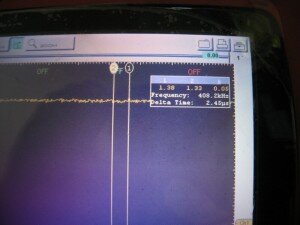Nice to see some real investigation into this. But if I had to guess I'd say there's a very good possibility that the voltage spikes are <50us. When you say your scope "refresh rate" is 50us, do you mean your scope takes a sample every 50us (i.e. 20 kSamples/s)? Or that each time division is 50us? In either event, that's probably too slow to see a voltage spike that occurs on a nanosecond scale. I have some nice scopes at work that can go down to nanoseconds, but getting a computer in here to test them would be rather difficult.
I chatted with a co-worker who has experience in power supplies and this is what we came up with as far as the voltage spikes go: it is far more likely to see a large spike going from heavy to light loads as opposed to light to heavy. Switching regulators on a motherboard have a feedback loop that makes sure the voltage is what its "supposed" to be. When the load increases, the feedback loop has a fixed slew rate that determines how fast it can react, and it will definitely be slower than the time it takes to go from a light load to a heavy load. The light-to-heavy spike comes from an overshoot in the feedback loop where it continues ramping the power up beyond what is necessary to maintain the voltage. But the feedback loop keeps chugging along and brings it back to normal very shortly after.
The voltage spike going from heavy-to-light is worse. Switching regulators work by storing energy in an inductor then passing it to the load. The output voltage is controlled by the duty cycle of a pulse-width-modulation signal used to do the switching. If the current goes beyond a certain limit, that voltage will start to droop because energy isn't being transferred fast enough. The solution is to increase the duty cycle to supply extra current. But if all of a sudden you drop the current draw (going to light load), the duty cycle is still longer, and since the regulator isn't strained the voltage will spike. The feedback loop comes into effect and lowers the duty cycle, but you'll still see a large spike before it reaches equilibrium.


